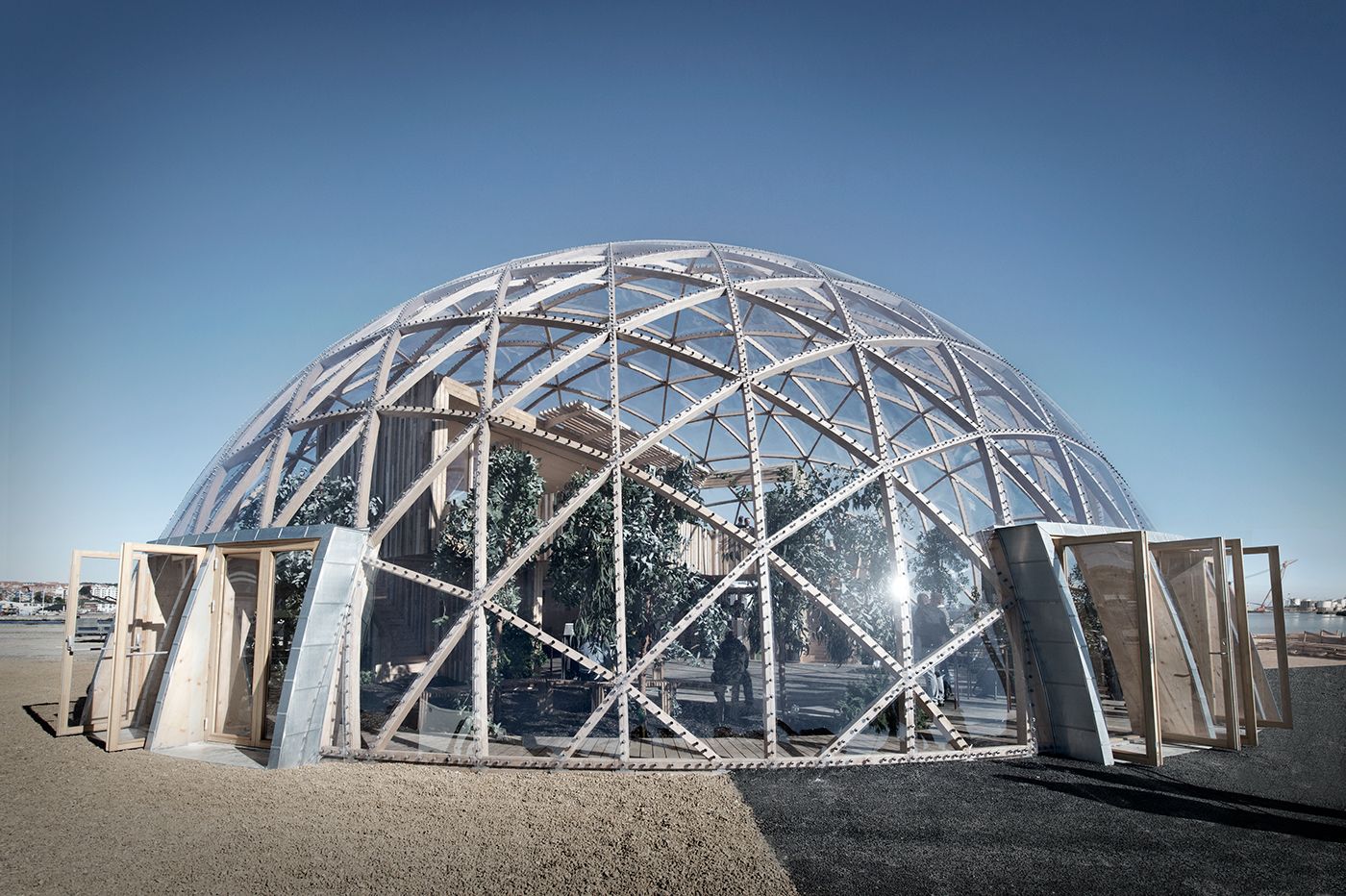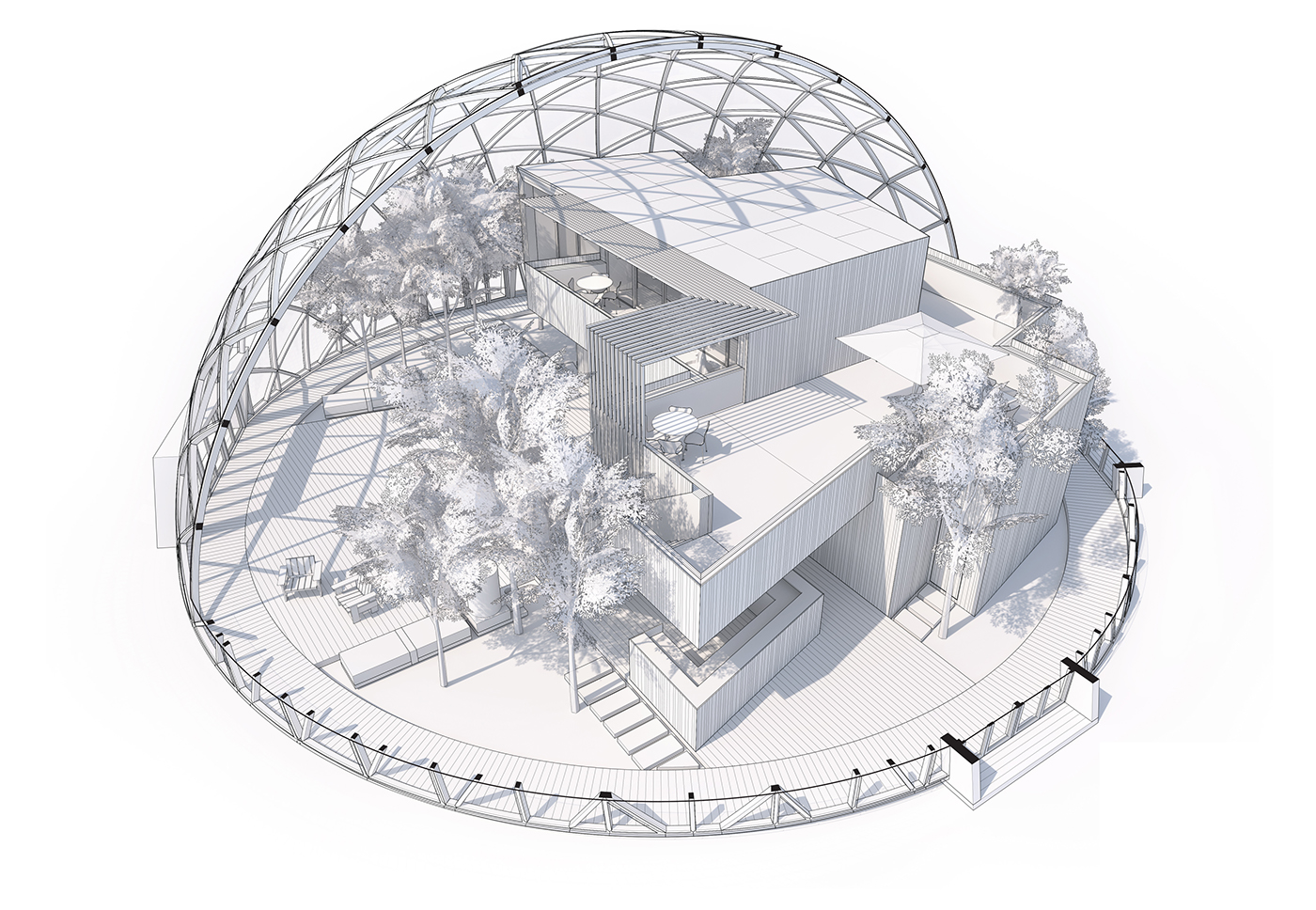
Dome of Visions 3.0 is the third dome in a series of experiments. DoV is an experiment that aims to create knowledge about how it affects our architecture and our well-being to build inside a greenhouse and work with a passive and solar heated space as a building envelope, that generates a third climate as the majority of the area we use.
A space that is neither inside nor outside and therefore provides a better space for a meeting between man and nature.
Uncertainty as a premise promotes a sensitivity – a sensitivity for the choices we make and the consequences hereof, for the space we create and the world we live in and live with. If we do something different, things will be different – hence, what we do and how we do it is important.
All construction is temporary; it is only a matter of perspective. The fact that Dome of Visions is ‘more’ temporary than many other buildings provides a stronger invitation to think about the circuits the materials are a part of and to contemplate how the building is constructed in order to be disassembled again as well as the ways in which the constituent-elements can enter the world in new ways. However, the thoughts are equally relevant and required in all other construction.
The meeting with the world is pivotal to a modern culture center such as DOV 3.0. We have chosen to meet the world with a responsibility and desire that this responsibility is embraced and put into dialogue. As a cultural center, DOV3.0 will form a framework where people with ease can meet in an open and safe space where ideas and thoughts can be exchanged and unfolded through trust. We want to make room for events where people can meet to evolve and where conversations can give weight to our understanding of the world.
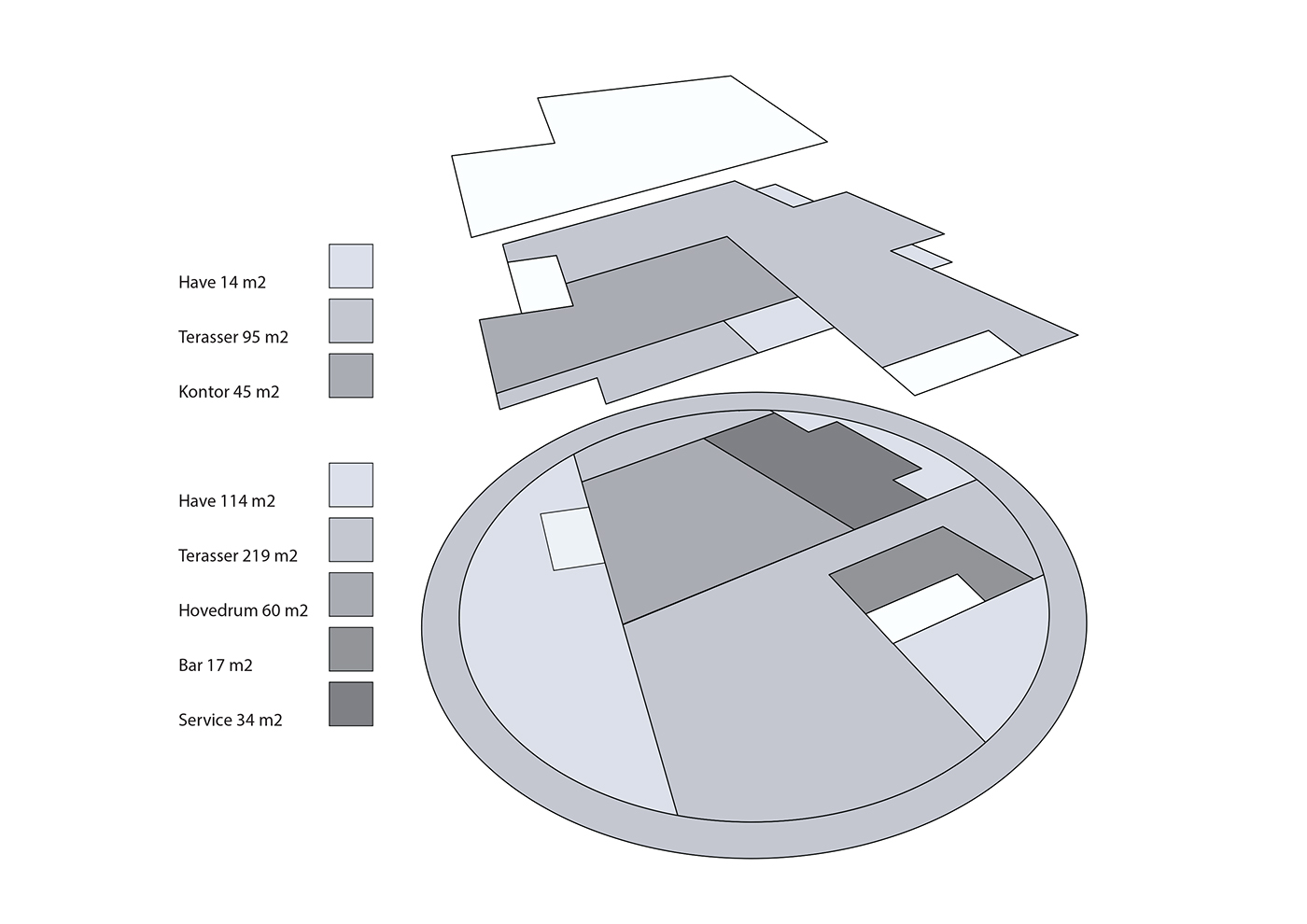
We can see that the Dome of Vision 3.0 serves as a framework where space has been created for a wide variety of events, lectures, debates, conversations, concerts and exhibitions that can open eyes, ears, thoughts and senses. Consequently, we feel confident that with DOV 3.0, we have created a place where people will meet to grow wiser through receptiveness and stronger through diversity; where knowledge of today has been utilized and continue to evolve in the meeting between people willing to reflect new ideas and solutions and start drawing the future - that our current knowledge has manifested itself in a snapshot pointing forward. For that we are both grateful and proud.
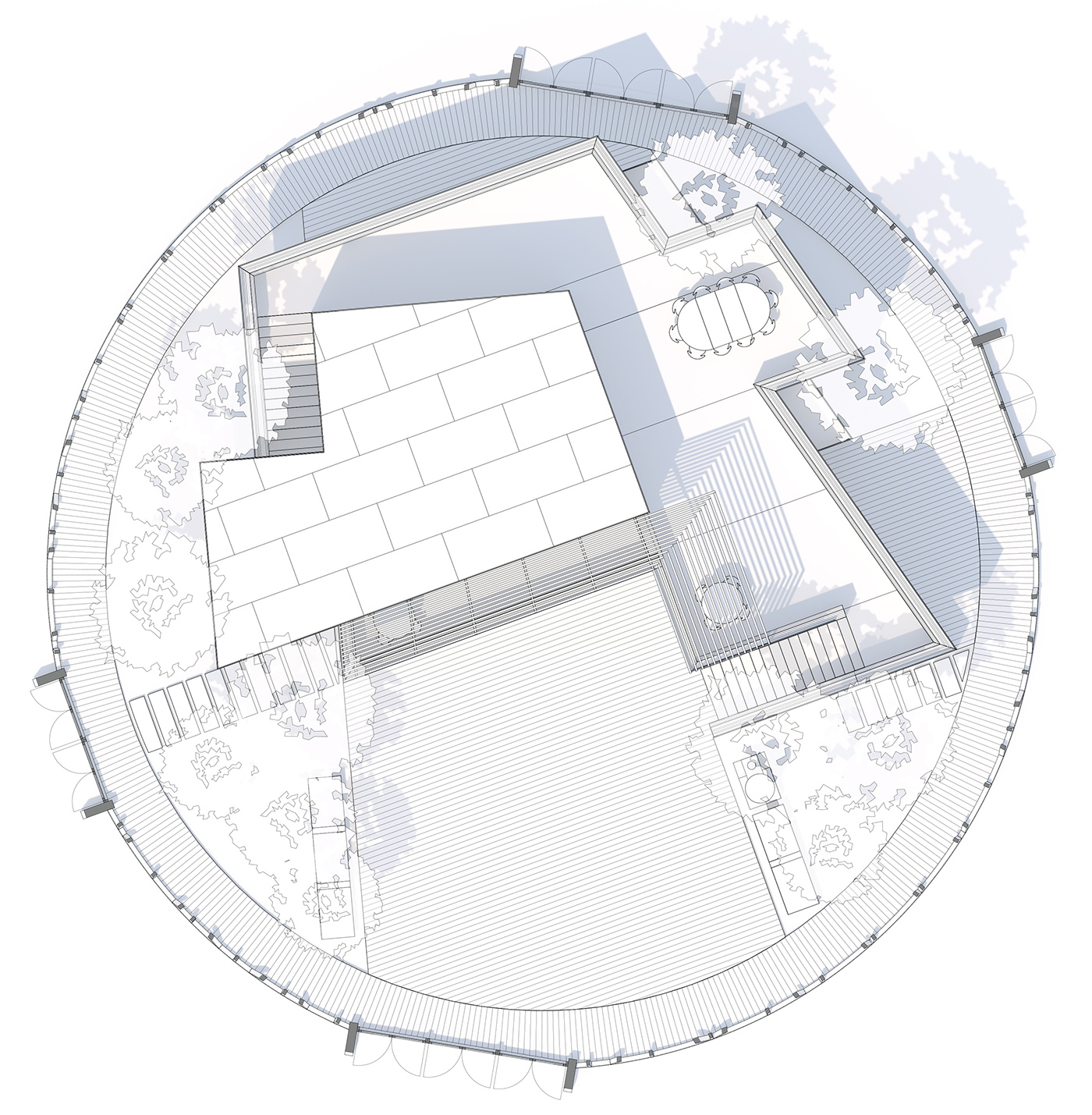
When we choose wood as the all bearing material in DOV 3.0 it is, based on our current knowledge, the sustainable choice. It also applies when we choose to let the knowledge of the material producers be co decision makers in designing the building’s elements. The same applies when we choose to let the material producers' knowledge be part of the design of the building's elements. It is the interaction that allows us to utilize the materials in the best manner; to optimize the material consumption in the design and reduce the amount of waste by respecting the material dimensions in the design process.
When the dome is clad with polycarbonate in rhombus shapes, instead of hexagons or triangles, waste is reduced from the sheets and at the overlapping joints. When the curved CNC-milled beams can be assembled in a simple laser cut steel node, the amount of steel is reduced and the production is optimized in a way that makes it easier to assemble and requires less energy. When energy is spent on carrying out a thorough digital modeling of the building, it helps to provide a more clear construction site and assembly process. When it is decided to let robots and machines do what they know best, it releases time for the craftsmen to focus on what they are passionate about. When the choices we make continually create simpler and easier structures as well as lowering the resource pressures on the globe, we know that we have made the right choices and that we have hit the right degree of sensitivity towards the spaces we create.
When the dome is clad with polycarbonate in rhombus shapes, instead of hexagons or triangles, waste is reduced from the sheets and at the overlapping joints. When the curved CNC-milled beams can be assembled in a simple laser cut steel node, the amount of steel is reduced and the production is optimized in a way that makes it easier to assemble and requires less energy. When energy is spent on carrying out a thorough digital modeling of the building, it helps to provide a more clear construction site and assembly process. When it is decided to let robots and machines do what they know best, it releases time for the craftsmen to focus on what they are passionate about. When the choices we make continually create simpler and easier structures as well as lowering the resource pressures on the globe, we know that we have made the right choices and that we have hit the right degree of sensitivity towards the spaces we create.

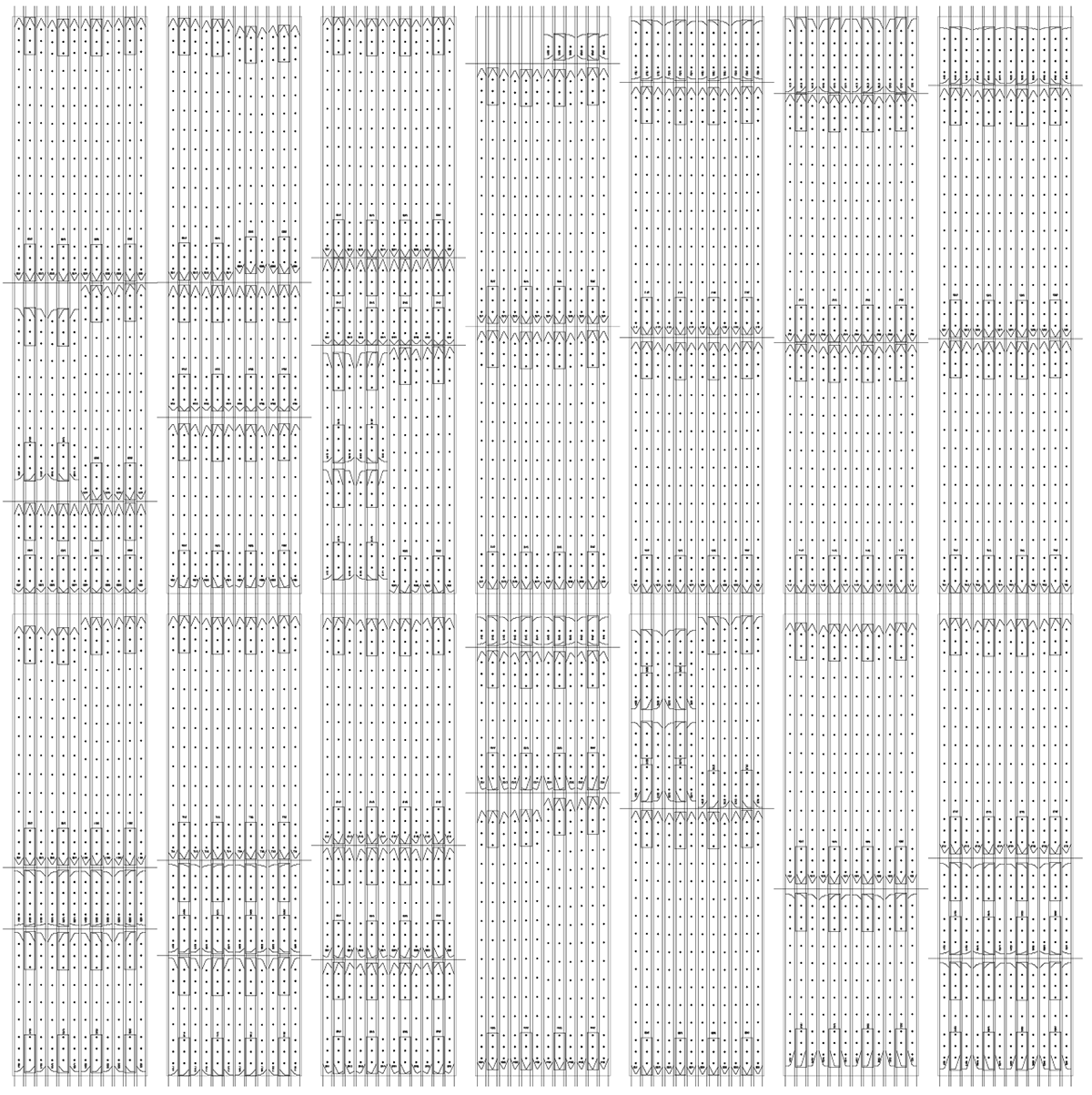
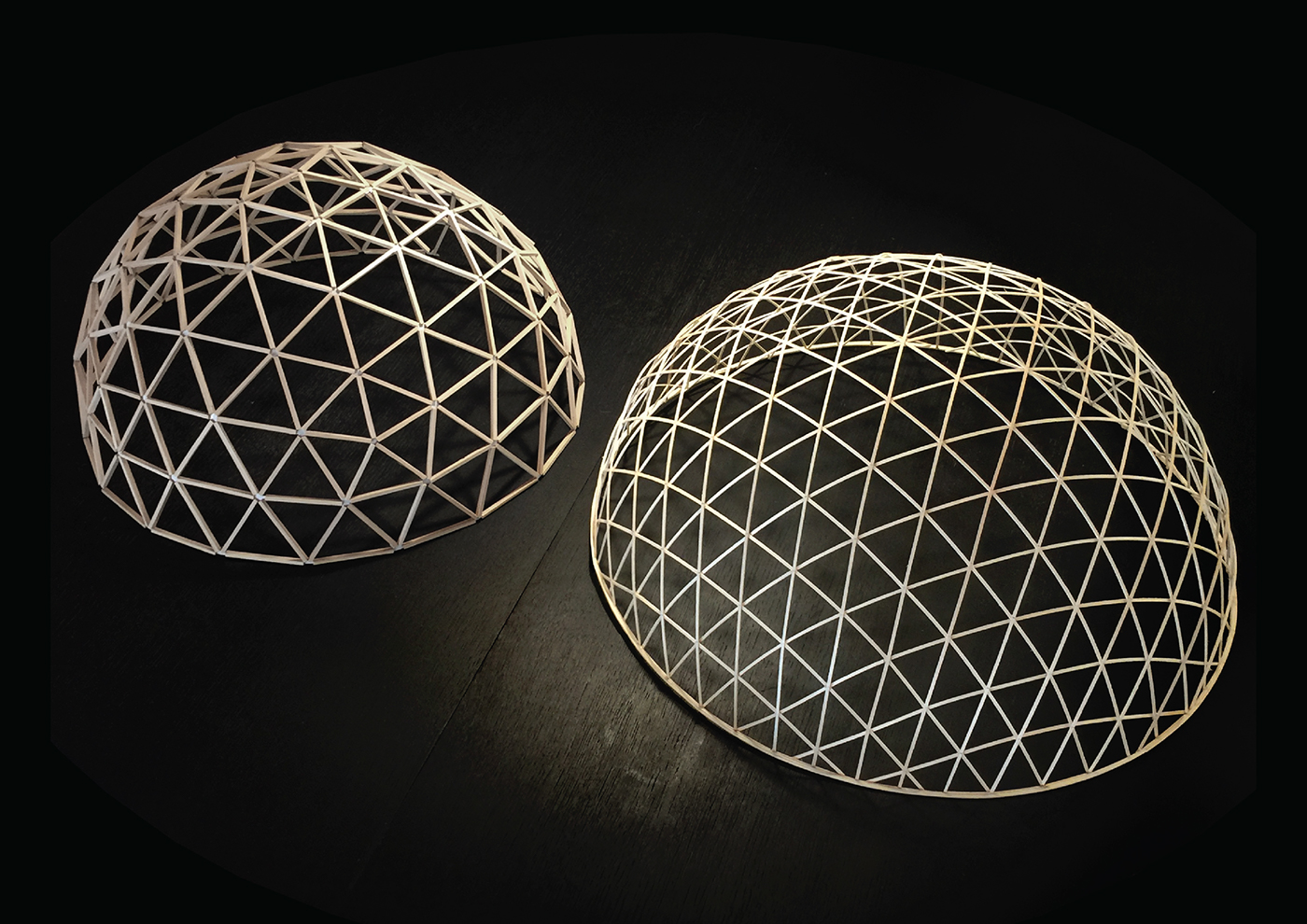
Dome of Visions is built on ambitions - and a love for wood
Link to stop-motion of the erection: Timelapse
Atelier Kristoffer Tejlgaard, sees sustainability in construction as an absolutely necessary and worthwhile entrance to their works.
Link to stop-motion of the erection: Timelapse
Atelier Kristoffer Tejlgaard, sees sustainability in construction as an absolutely necessary and worthwhile entrance to their works.
To his students, the former Pritzker award winner, Glenn Murcutt, formulated a very elegant approach to architecture: "Touch the Earth Lightly with your housing footprint", and with that he did not only consider a building built on a few pillars. He asks the question: Where does the building materials come from? What damage has been done, for example, in the land area where the materials are extracted? How will the construction be returned to the ground again, or can it be recycled, recycled or assembled in a way so that it can be separated, changed and used in new contexts?
These questions are also essential in the design principles of Dome of Vision 3.0, which was built in the autumn of 2016 at the port of Aarhus, among others. As part of the fact that Aarhus is the European Capital of Culture in 2017.
Nature as a factory
According to architect Kristoffer Tejlgaard, wood is the building material that best approaches a true sustainable material for construction. He starts with a metaphor:
-Wood as a building material has some clear advantages when we speak sustainability in construction. In principle, we have to do with a material that comes from a solar-powered factory, which supplies its raw material, CO2, from the atmosphere and transforms it into a material that contains an incredible variety of applications. In addition to reducing the amount of CO2 in the atmosphere during production, the factory's waste product, is oxygen. If we look at the factory's location, it has the potential to be one of the most biodiversal areas of the globe. There is, of course, a criticism of the industrial woodlands that become monocultures, but it is possible to cultivate industrial forests that are biodiverse. It's a pretty amazing factory if you think about what process goes in to producing this material and the uniqueness in that production itself, is a quality, he says.
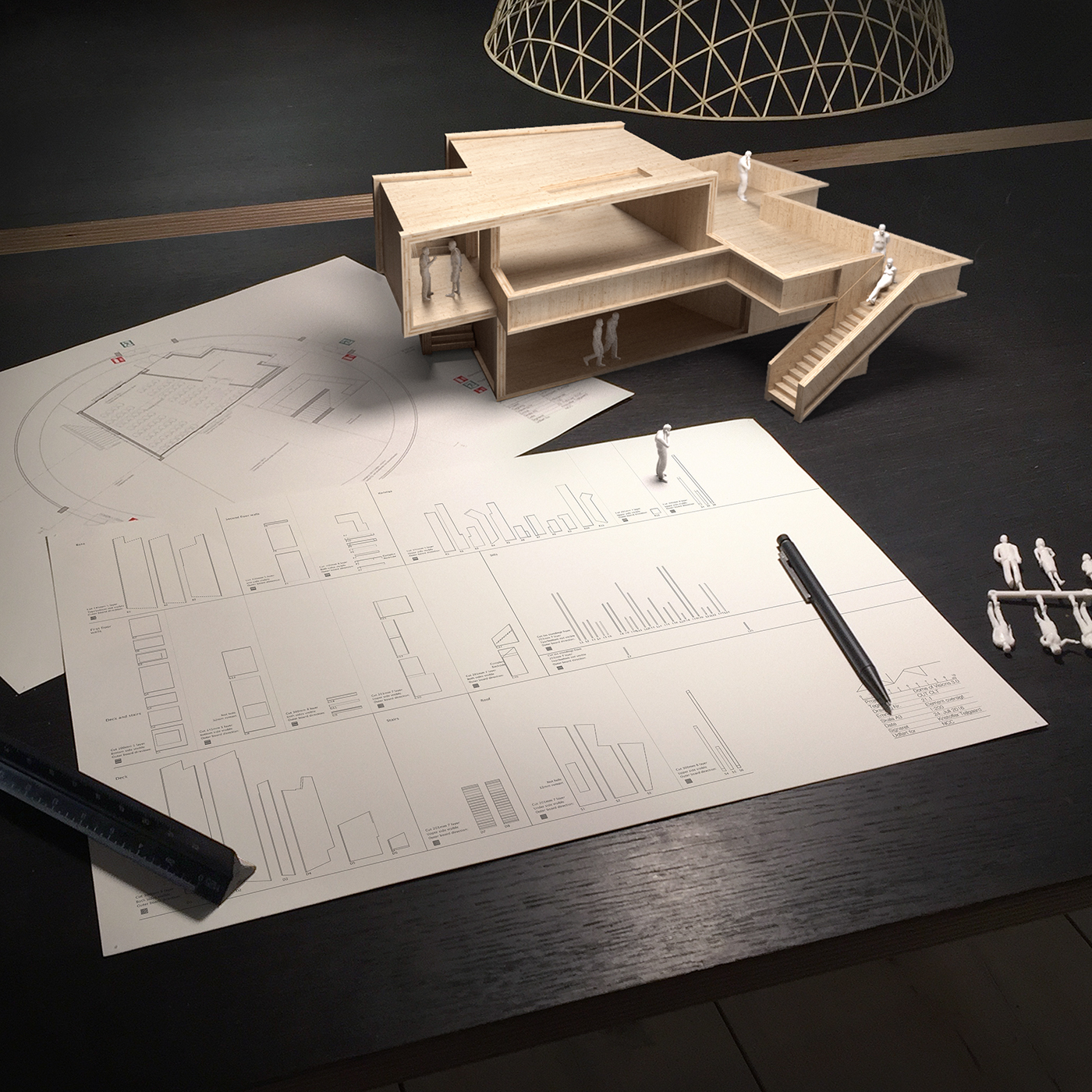
When trees are allowed to live their lives in the woods and rotten on the forest floor, they release the collected CO2 back into the atmosphere again. Kristoffer's point is that if we do not use the forest as a factory that provides us with a building material, we miss out on the beneficial storage of CO2 that trees provide us with.
The question is then how we relate to buildings not standing forever and that CO2 contained in wood, whether in the forest or in our buildings, will inevitably be released to the atmosphere again. Kristoffer continues:
-It is so that if we take good care of our timber constructions, they have the potential to last for hundreds of years, which may be enough to affect the CO2 curve in a positive direction. Even if the buildings arent erect for that long, you can imagine more positive uses for the wood after demolition. You could easily store these wooden elements in warehouses whose purpose is to preserve the captured CO2. The warehouse could thus be built of old building components and at the same time be part of a circular economy, where elements were transformed into new building materials. Tells Kristoffer and continues:
"A material like CLT, for example, is a pure enough material to imagine being converted it to OSB, MDF and wood fiber insulation Kristoffer says before he Concludes:
-If the alternative is that the tree stays out in the woods, crumbles and thus releases CO2, we can as well release that CO2 in a way that makes sense. Initially it would be to throw it in a wood-burning stove, burn it and draw energy out of it. Yes, then we would release the CO2 again in the same way as if we let the tree lie and die in the forest, but we will at least retrieve energy and heat, energy that would otherwise have cost CO2 to produce. So even though we burn it, we can potentially save CO2. If we make energy and heat from, for example, solar cells, then it has a cost CO2 to produce the solar cells. Even in extreme consequence when burning the wood, we actually achieve a CO2 saving compared with other alternatives, he concludes.
The alternative
Dome of Visions has a format that allows the contractor NCC and the studio Atelier Kristoffer Tejlgaard to experiment with alternative constructions and materials. Since the Dome of Visions 1.0 was built in Copenhagen back in 2013, wood as material has become an increasingly important part of the project.
-Dome of Visions is thus a tribute to the joy of building and working with wood. PEFC and FSC certified wood has been used in the project because a labeling scheme ensures that PEFC and FSC wood comes from sustainable forestry. The use of this type of wood is a step towards a best-practice management when it comes to maintaining rainforest and keeping the forests in Europe growing. As already mentioned, wood plays an extremely important role in the large CO2 accounts, because wood is capable of storing CO2. If we do not start using more wood in our buildings, statistics show that current wood production in Europe is too big. The consequence will be that industrial forests become fewer, says Kristoffer Tejlgaard.
For these reasons, he wishes to use as much wood, and as little steel in the building as possible. Thus, many different types of wood have been used in the design of the Dome of Visions.
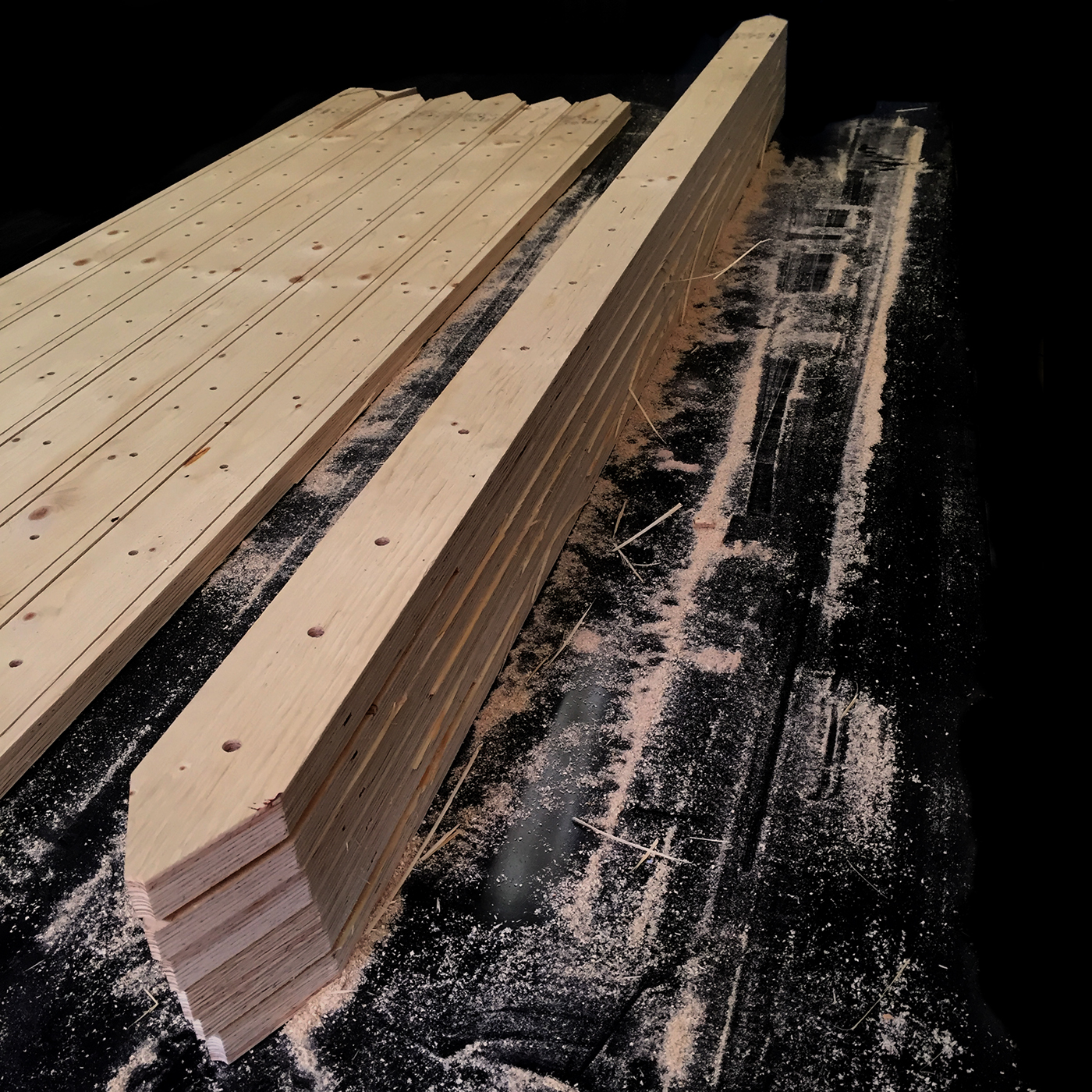
Curved Glulam
The foot strap on which the dome grid rests consist of six large pieces of curved glulam and forms the circular foundation of the dome. The foot strap rests on a screw foundation consisting of two to three meter deep screws divided into 46 points anchored in the ground. The outer door parts have curved frames made in CLT, produced in Austria by KLH. The doors that are located in the frames have the construction company Egen Vinding and Daughter, and they are produced by cuttings.
-In an attempt to minimize the amount of steel in the dome and at the same time get a sleek and elegant dome lattice we developed a new system. Using curved wooden beams, the dome's nodes are able to be cut as star shaped nodes in five millimeter sheet steel, thus avoiding the complicated and costly welded nodes from the first two versions of the Dome. However, a challenge in this system was to mill curved slots in the beams for the steel nodes. The solution was that each beam is made up of six layers of 20 mil KERTO LVL strips. By CNC milling the strips at MARKANT A / S, it became possible to mill a groove for the nodes before the bonding process, says Kristoffer Tejlgaard.
At MARKANT A / S there is the possibility of CNC milling sheets up to 8x2.1 meters. In the design of the dome structure, a lot of effort was put into optimizing the designs to avoid waste. All components in the dome are therefore dimensioned according to this format. In connection with the production of the individual LVL strips for the rods, 2,322 cutting files were made by the architect for CNC milling. The gluing of the beams was Flexwood A / S.
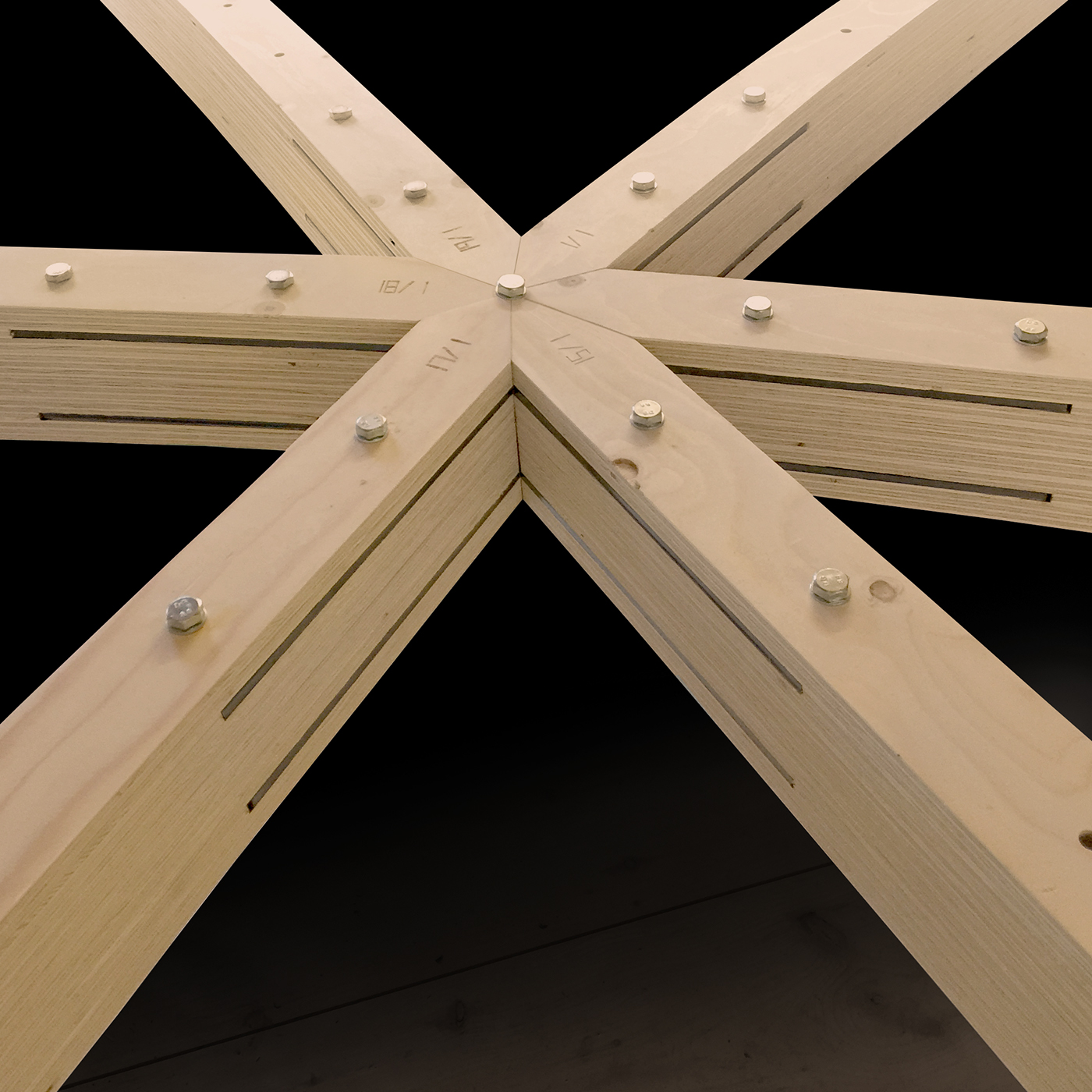
Precision
The normal rutine of gluing the wood first and then milling it afterward, was turned upside down, which required a very high degree of precision from the manufacturer as the beams were milled to the final measures and the bonding had to be be controlled with a precision within one millimeter. This was achieved by using curved templates and steel rods through all of the layers in each beam. The control holes were used in the final building to attach the transparent polycarbonate facade with threaded rods and bolts. The beams were made in 186 variants, and a total of 588 beams were produced.

Cross-Laminated Timber
The house, which facilitates many of the activities taking place in the the dome, in Denmark CLT is a relatively untested material. CLT, cross-laminated timber extends the possibilities for modern building in wood. CLT is suitable for prefabrication, which provides an efficient construction process. In collaboration with engineer Henrik Almegaard, Kristoffer Tejlgaard tried to exploit the properties of the material as much as possible. The CLT element, which is located between the living room and the first floor in the front of the house, is a maximum utilization of the material. The house is dimensioned according to what a CLT element can maximally carry. The longest CLT sheet you can get is 16 meters long and three meters wide. The sheet size works as dimensioning for the inner house, and the house fully utilizes the maximum dimensions.
The house is build from 100 different pieces of CLT, which is doable because its CNC milled and not cast as concrete, that would make it very expensive to make a 100 individual pieces
The house is build from 100 different pieces of CLT, which is doable because its CNC milled and not cast as concrete, that would make it very expensive to make a 100 individual pieces
For the architect to, CLT is heading towards a big future as a building material - but not without challenges. One of the major challenges for CLT in future construction is that CLT must be kept dry. Therefore, much of it is hidden behind different types of cladding. But not in the dome. Here the wood is kept dry and therefore it is possible to expose the material clearly, rather than concealing it. For that reason, a virtue has been made of showing what CLT can do. The design is not aiming for what is easiest, but on the contrary, what the material is able to do.
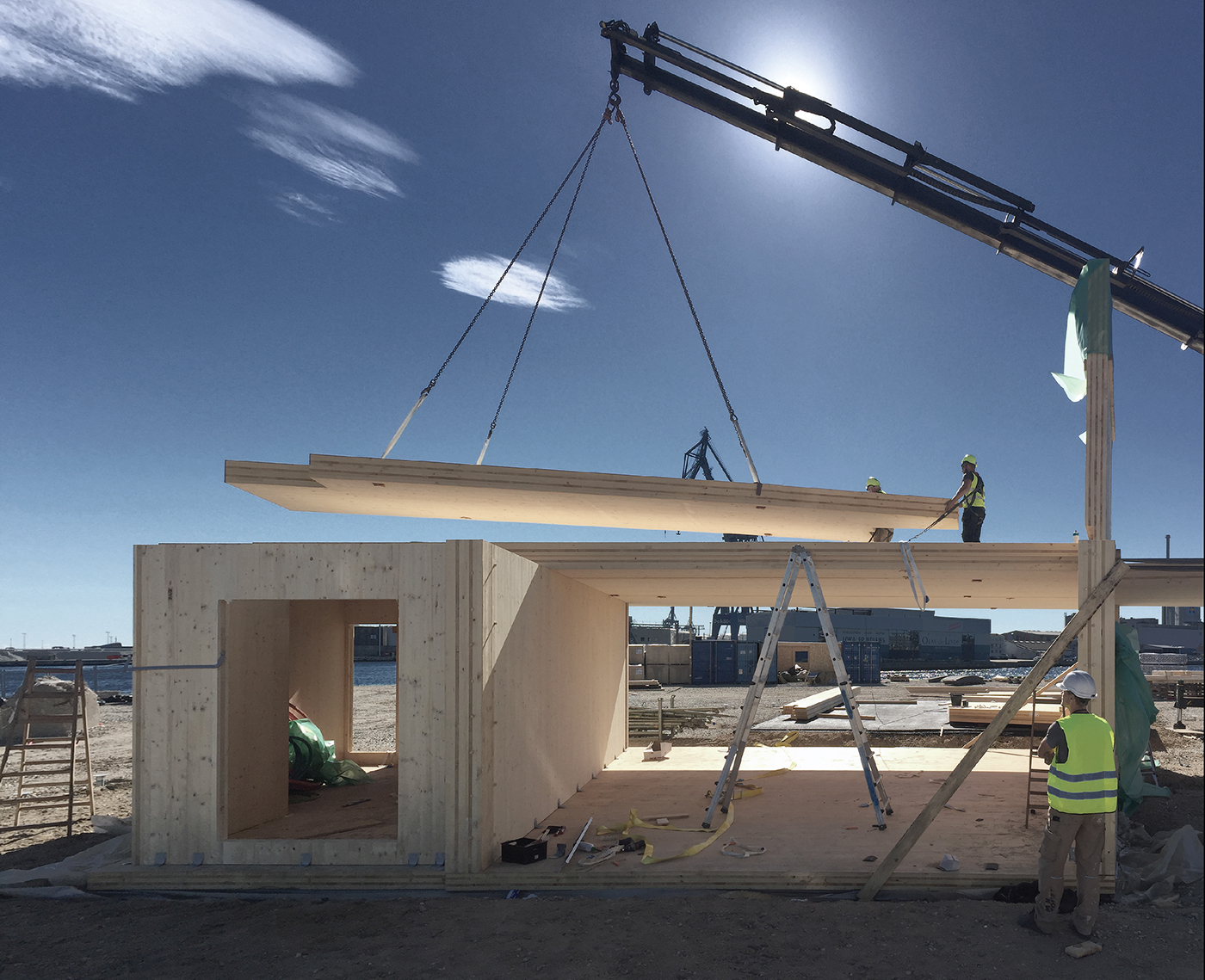
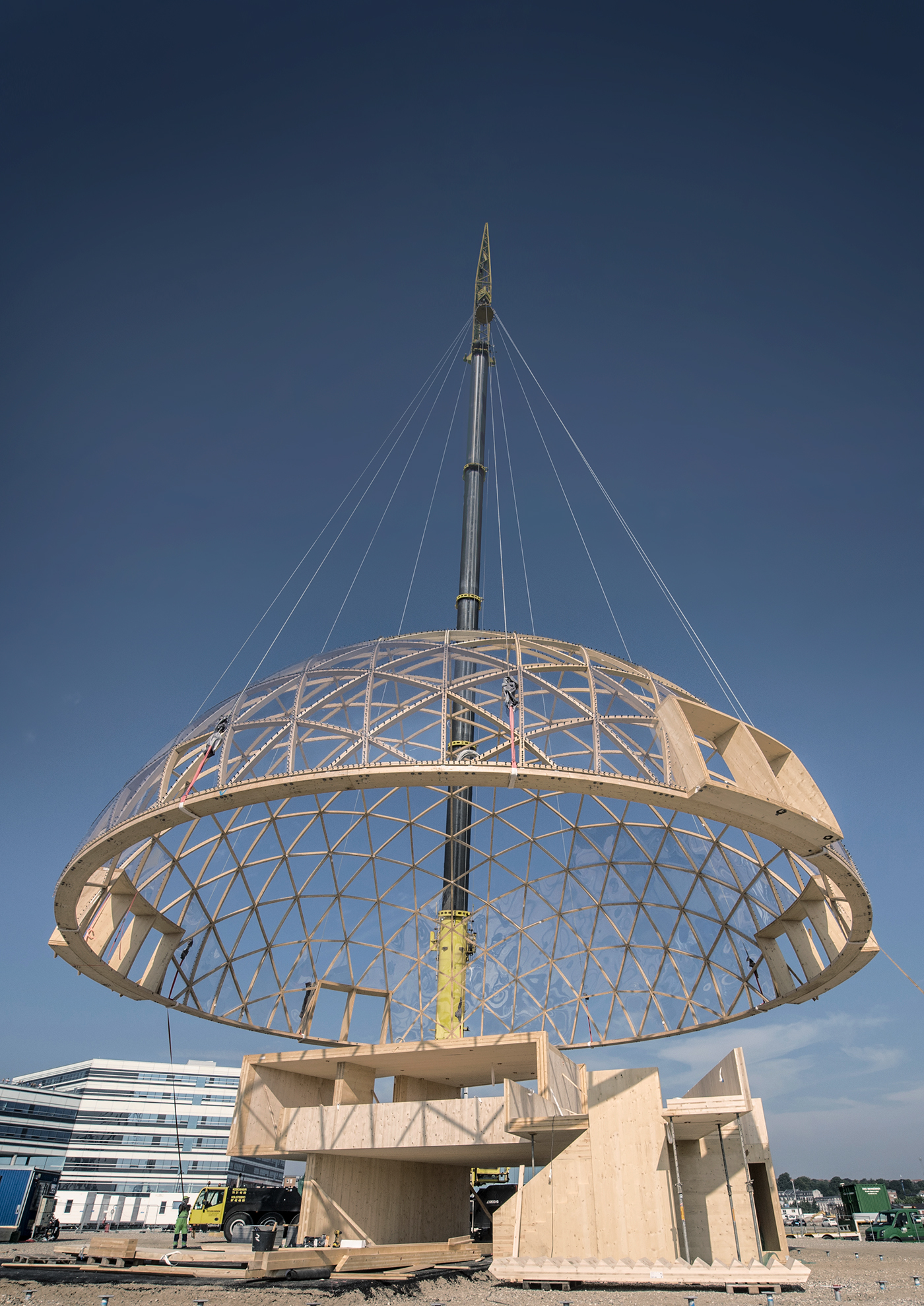
To build in a greenhouse
The dome, which acts as a building envelope for the inner house, obviously shields from rain and wind, but due to the fact that it is a greenhouse, and only heated by radiant heat from the sun, the dome will in the colder months will reach lower temperatures.
The house is therefore isolated to provide space for events during the winter months. Here, wood plays a further role, using different types of homaterm wood fiber insulation. By isolating the outside of the house, it became possible to expose the CLT inside and achieve a complete interior of exposed wood. One of the advantages of wood fiber insulation is that it comes in sufficiently hard plates that the facade can be mounted directly on to the insulation and ensure an easy and fast process, in addition to the obvious environmental considerations.
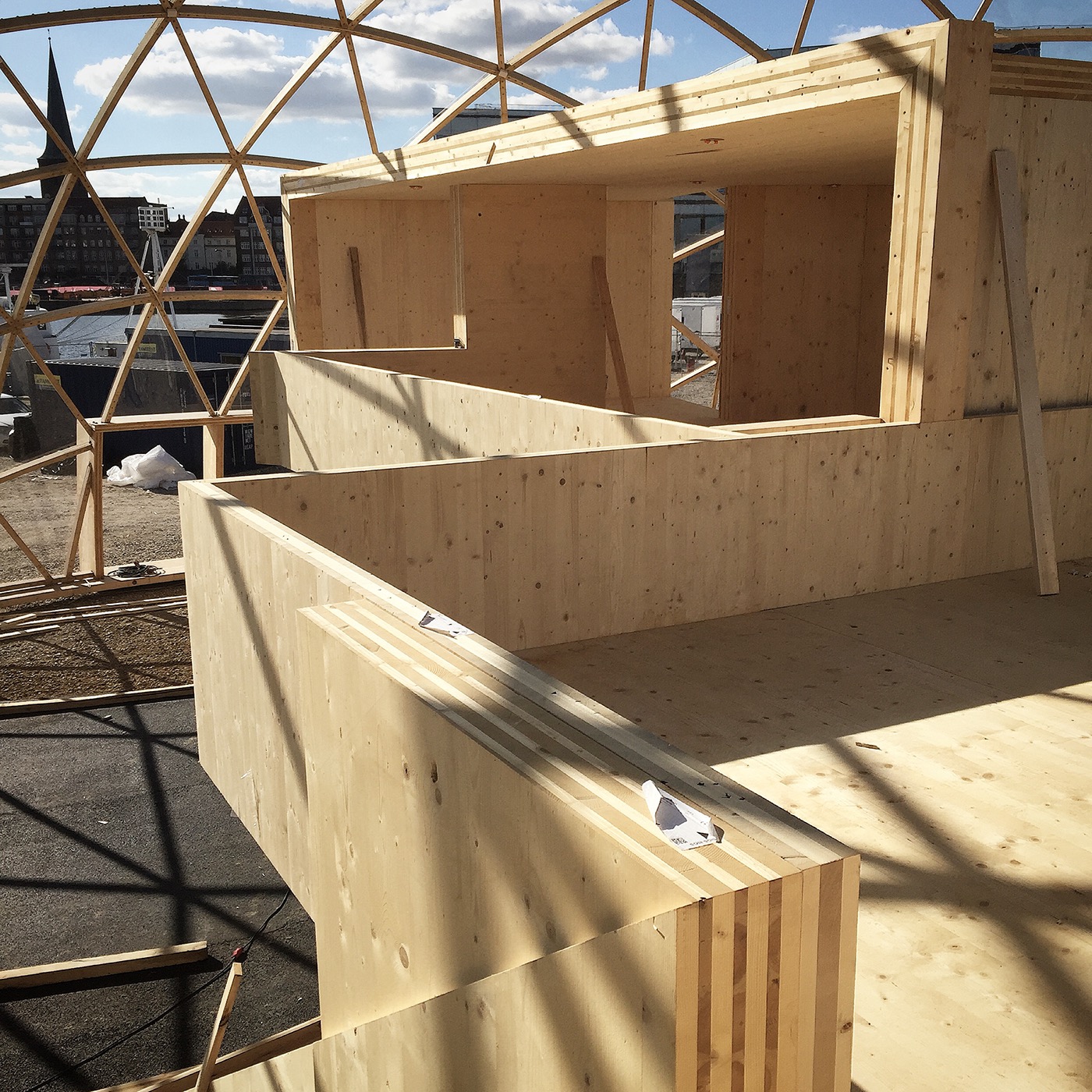
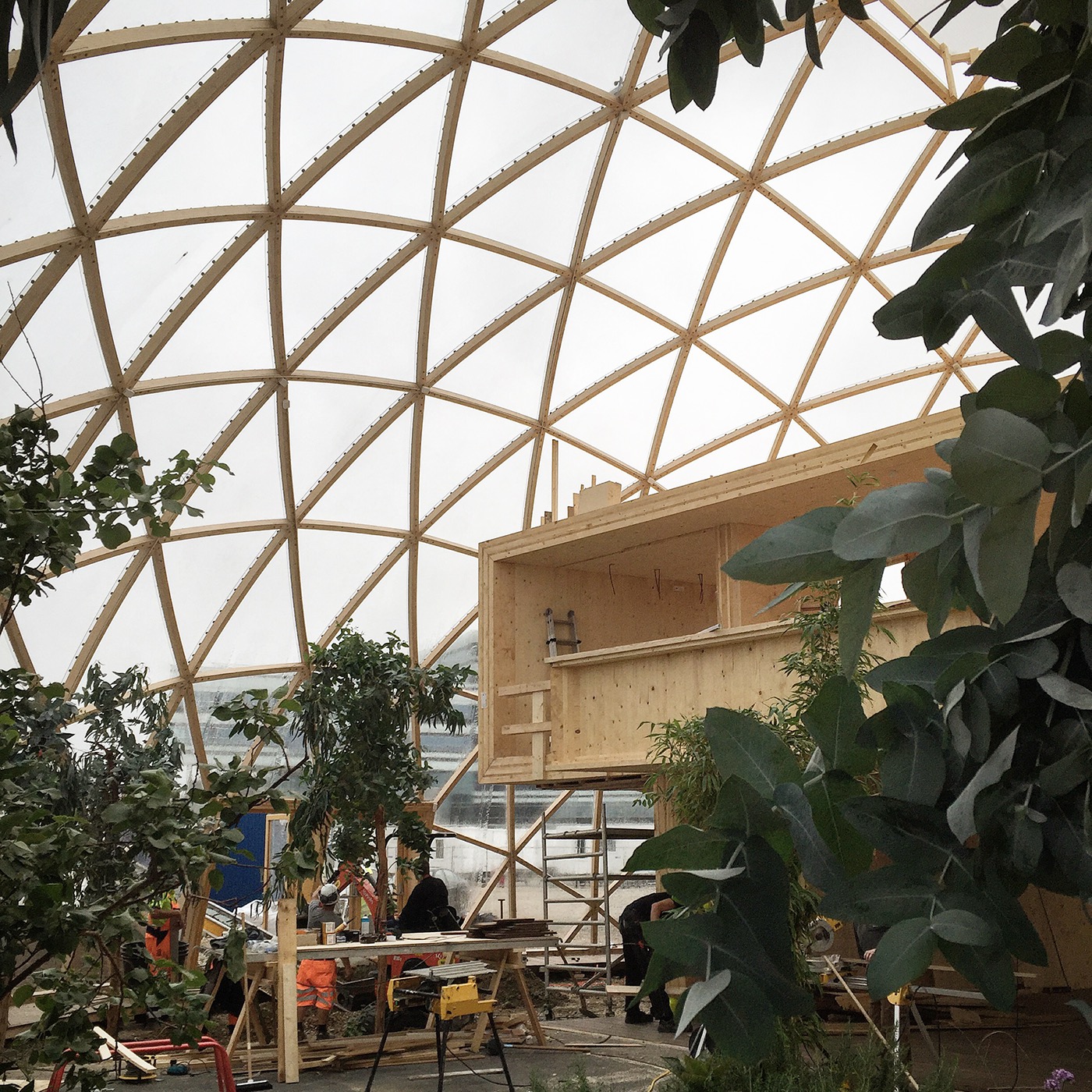
Upcycling wood
The wood fiber insulation is covered with a facade of reclaimed wood brought to Aarhus by NCC Recycling in Odense.
"Using wood, that has a patina from a prior life, helps to create a atmosphere and, according to Kristoffer Tejlgaard, is both poetic and picturesque. Personally, he might be a little afraid that the dome in Aarhus was a little too nice, a little too clean, meaning that all materials are new and dont in themselfes contribute a lot to the story of Dome of Visions. The recycled boards pull in the right direction, says Kristoffer Tejlgaard.
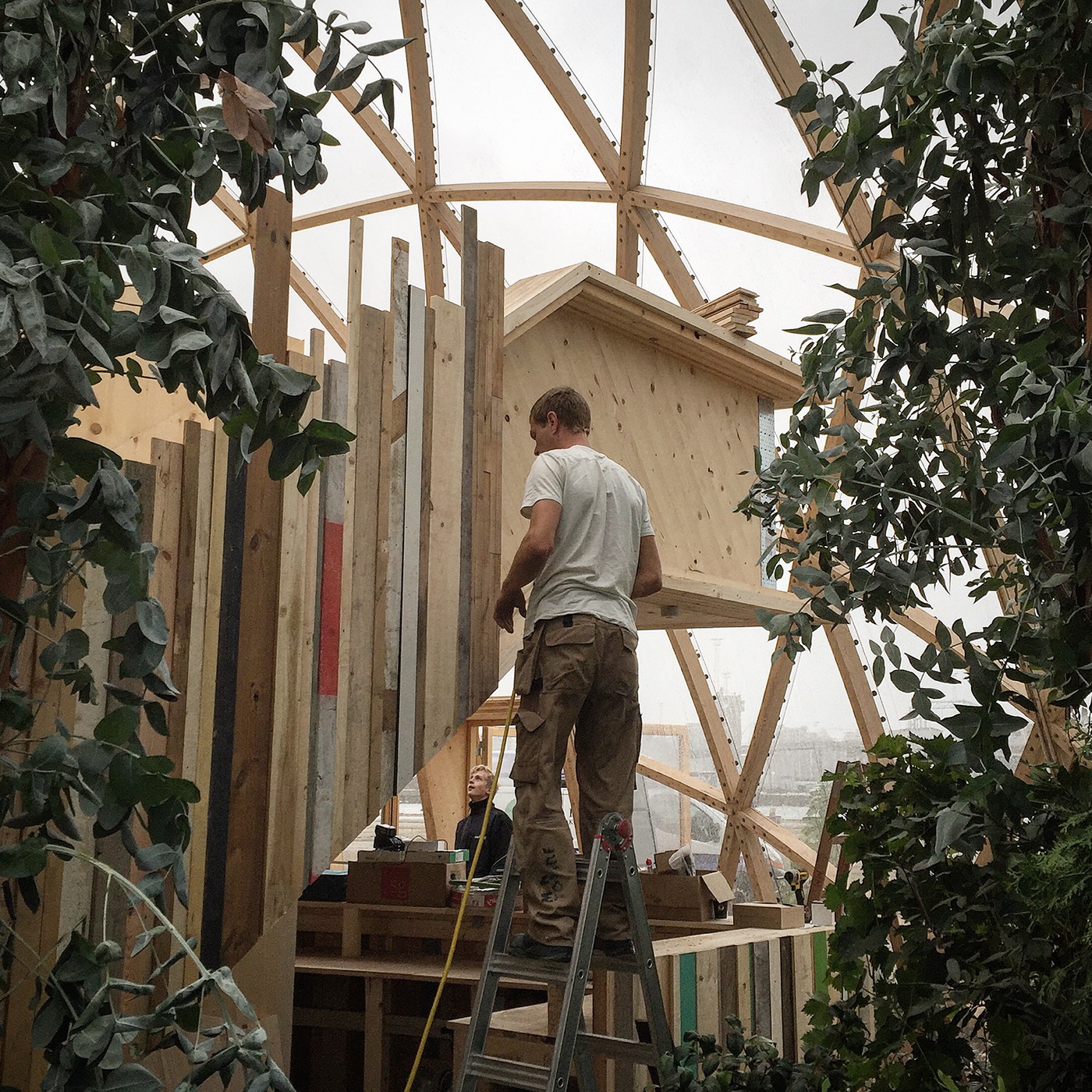
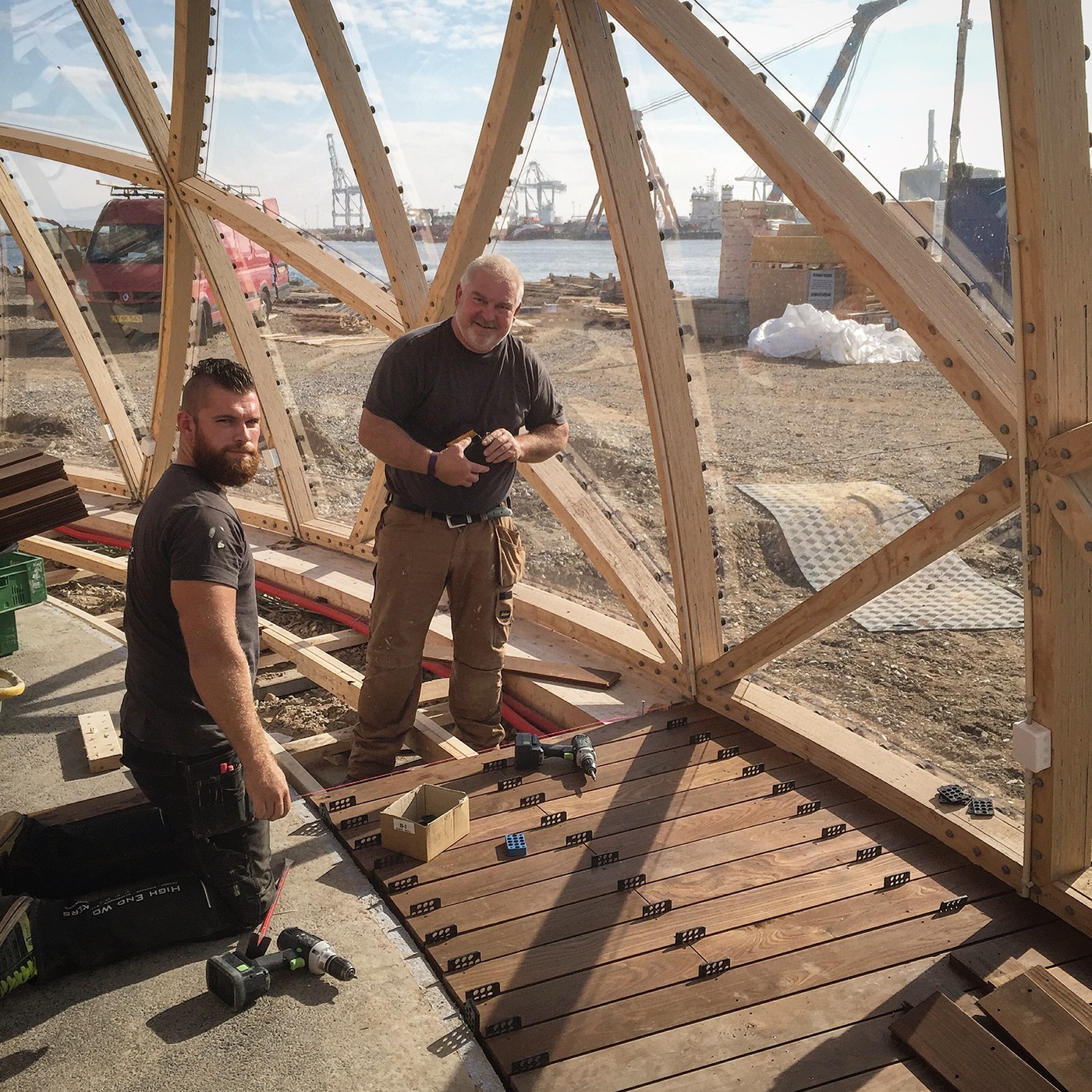
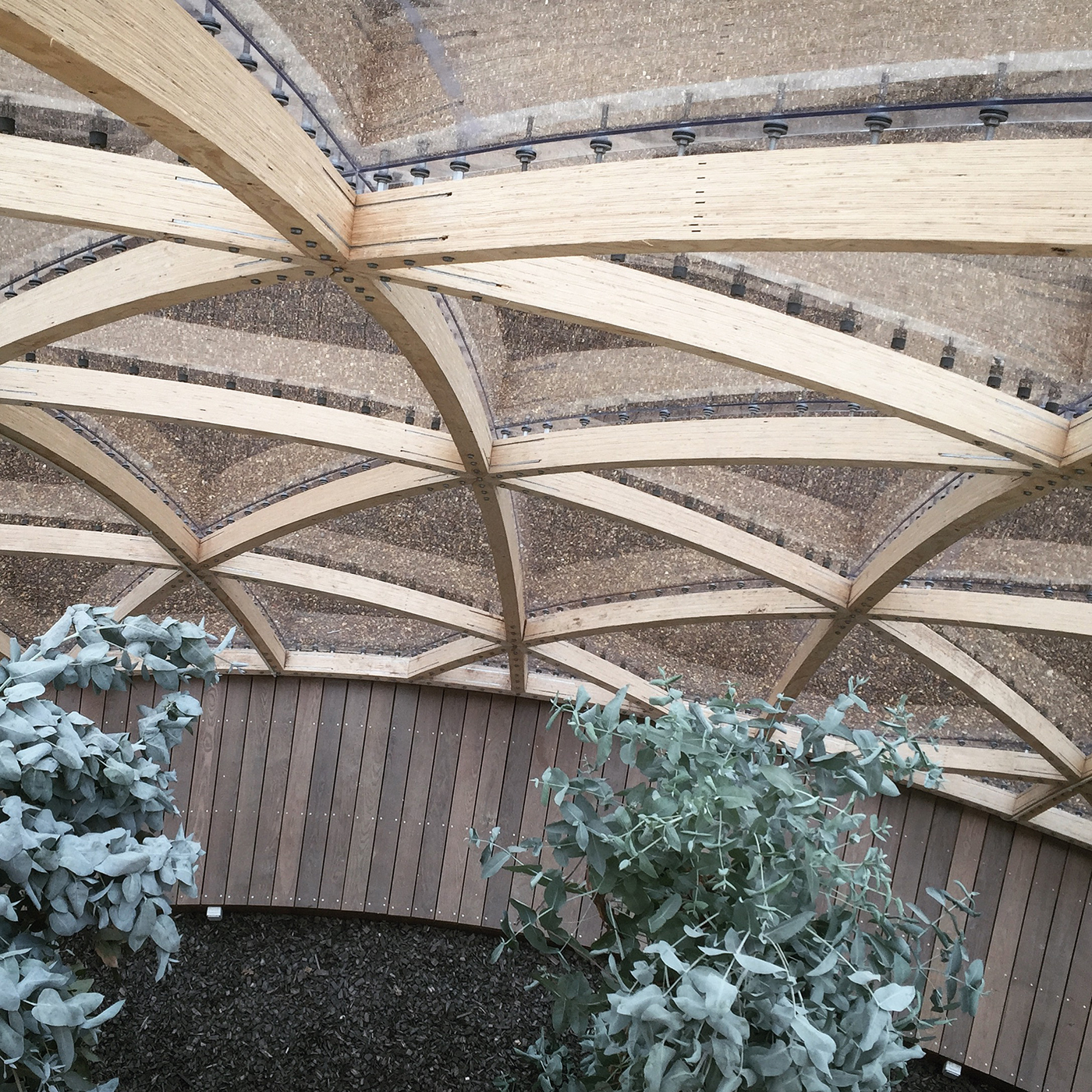



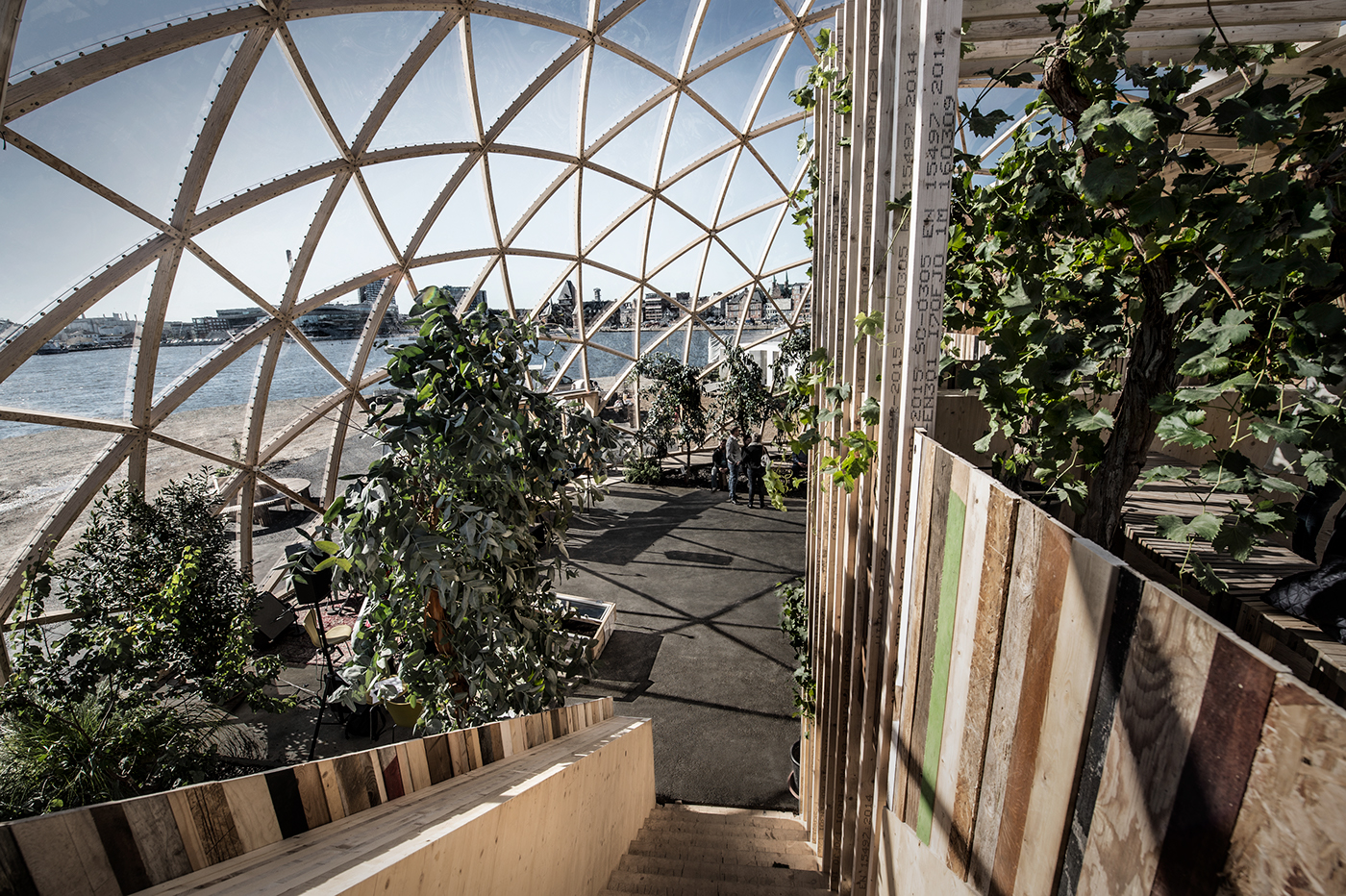
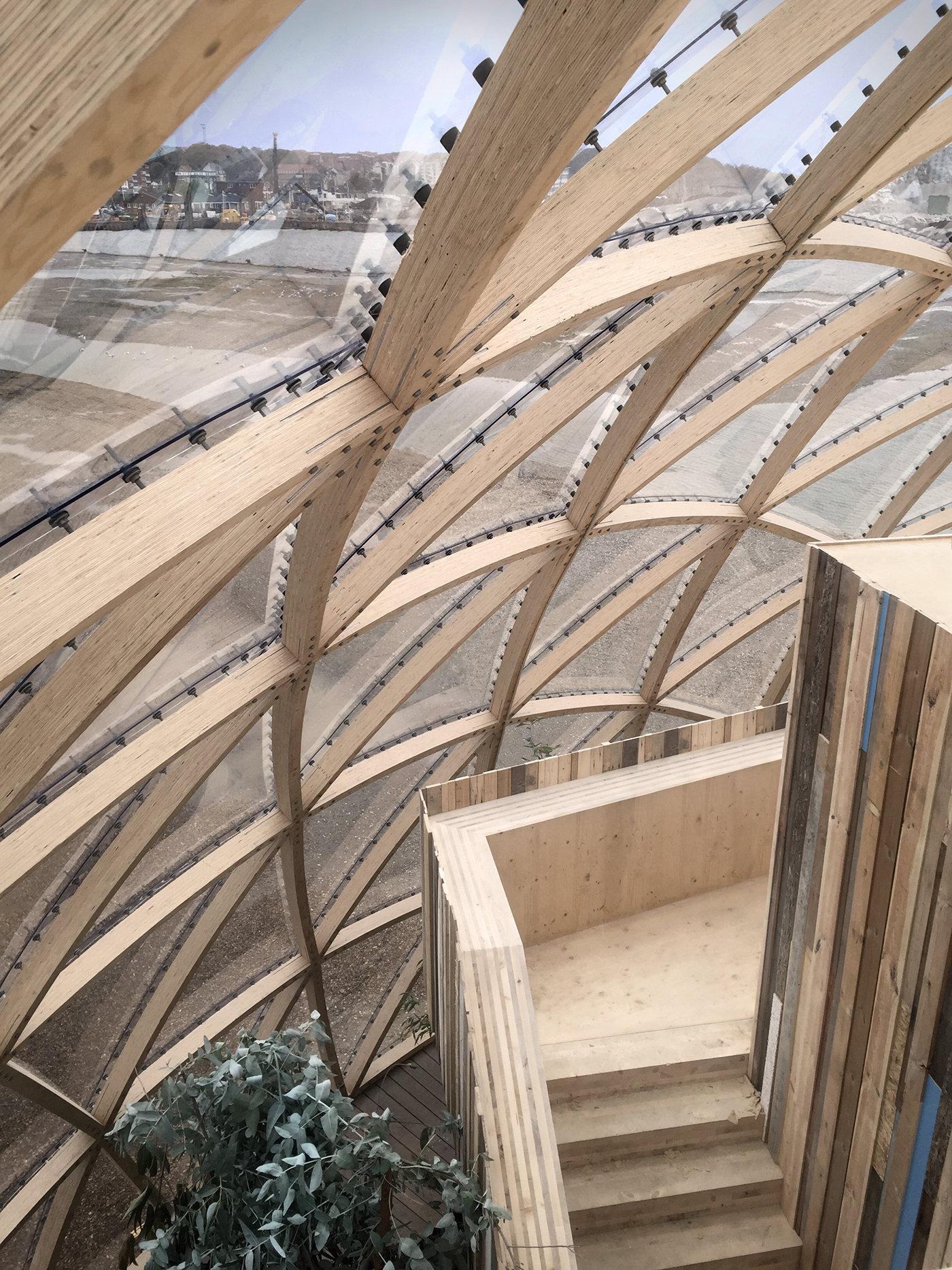
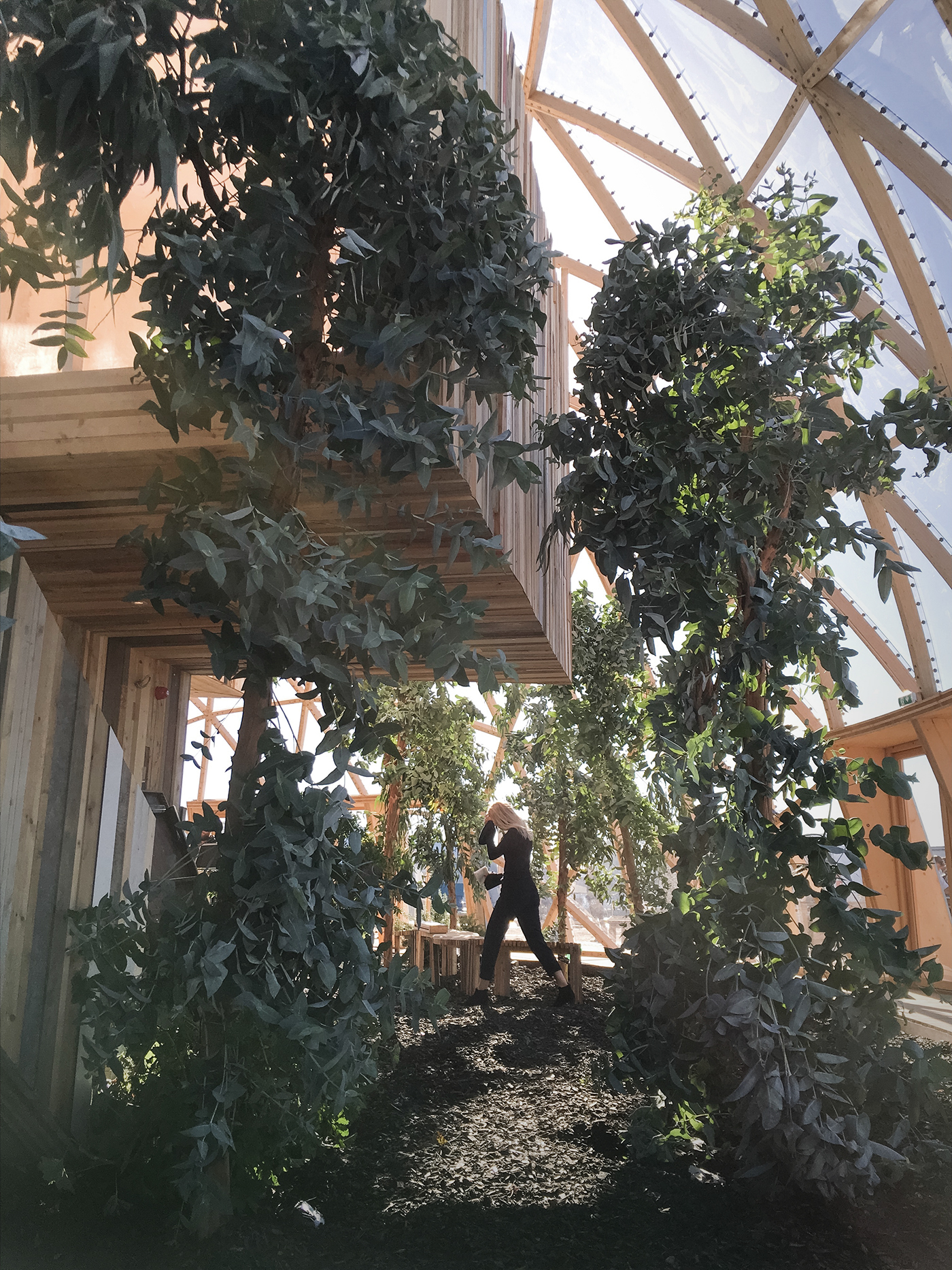

Facts:
The dome:
Dimensions: 24m diameter, 10,5m height
Footprint: 450m2
Garden: 130m2
Volume: 2.950m3
Surface area: 794m2
Beams: 588
Nodes: 282
Facade: 283 6mm sheets of polycarbonate
Top opening: 25m2
Bolts: 8.600
The house:
Area groundfloor: 120m2
Area first floor: 140m2
CLT: 100 m3
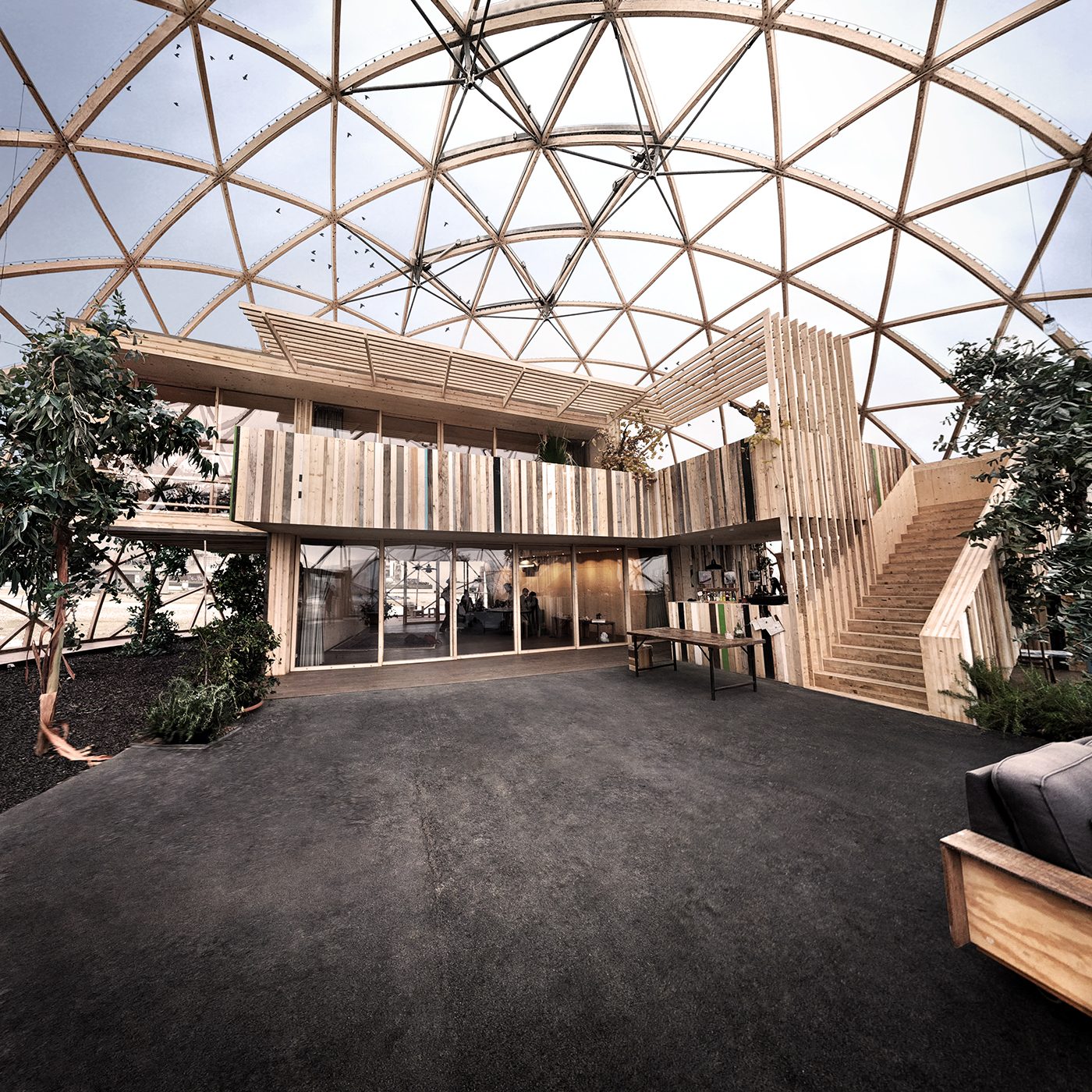
If you made it this far, please follow us on instagram Atelier Kristoffer Tejlgaard to stay updated on our projects.
And look further into the dome at www.domeofvisions.dk
